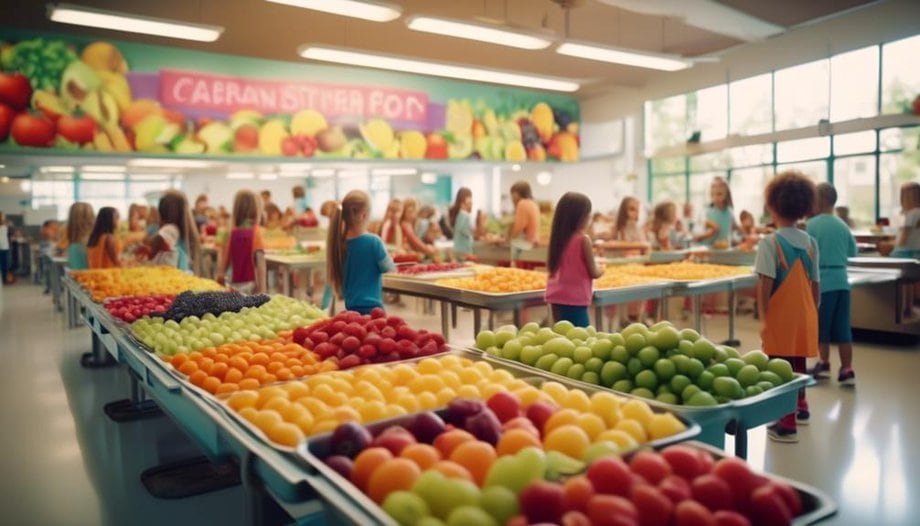How to Empower Kids to Make Healthy Food Choices at School

Empowering kids to make healthy food choices at school is possible through practical strategies and tips. These strategies and tips make healthy eating fun and enjoyable for children. By incorporating these strategies, children can develop knowledge and skills for a lifetime of good nutrition and overall well-being.
Importance of Nutrition Education
Nutrition education plays a crucial role in increasing awareness of healthy food options and empowering kids to make informed choices. By providing students with the knowledge and skills necessary to make healthy food choices, nutrition education sets the foundation for a lifetime of good eating habits.
Research shows that when children have access to nutrition education, they're more likely to choose fruits and vegetables over unhealthy snacks and sugary beverages. This education also helps children understand the importance of balanced meals, including whole grains, lean proteins, and low-fat dairy products.
Moreover, making nutrition education engaging and fun can further encourage positive associations with healthy foods. Activities like apple tasting contests and salad-making competitions not only teach children about different food options but also make them excited to try new things. By incorporating hands-on experiences, such as schoolyard gardens where students can plant and harvest their own produce, nutrition education becomes more tangible and memorable.
Empowering students to share their knowledge through student-led initiatives like video announcements enhances peer influence and promotes a culture of awareness. When children see their peers making healthy choices and advocating for nutritious foods, they're more likely to follow suit.
Additionally, schools can support local agriculture and foster a positive attitude towards healthy eating by highlighting locally grown foods in their menus and encouraging children to try new foods.
Creating a Healthy Lunchbox
To create a healthy lunchbox, start by offering a variety of nutritious options that appeal to your child's taste preferences and dietary needs. Empower kids to make healthy choices by involving them in the process. Ask them to help choose fruits, vegetables, whole grains, and lean proteins. Make it fun by including colorful fruits and vegetables, like cherry tomatoes and bell peppers, and encouraging them to try new foods. Get creative with presentation by using fun-shaped sandwich cutters or arranging fruits and vegetables in a colorful and appealing way.
In addition to offering a variety of healthy options, it's important to educate kids about the benefits of nutritious foods. Teach them about the different food groups and why they're important for their health. Discuss the importance of balanced meals and the role that each food group plays in providing essential nutrients.
To further empower kids, involve them in the preparation and packing of their lunchboxes. Encourage them to help wash and peel fruits and vegetables, assemble sandwiches, or portion out snacks. This not only teaches them valuable life skills but also gives them a sense of ownership over their food choices.
Teaching Kids to Read Food Labels
Now it's time to delve into the importance of teaching kids to read food labels.
By understanding label literacy basics, children can make informed decisions about the nutritional content of the foods they consume.
With visual aids and interactive activities, kids can learn to identify key information on food labels, such as serving sizes and ingredient lists.
This knowledge empowers them to recognize hidden ingredients and prioritize essential nutrients when choosing healthy food options.
Label Literacy Basics
Teaching kids to read food labels empowers them to make healthier choices by understanding key information and identifying deceptive marketing tactics. Label literacy basics are crucial for equipping kids with the knowledge they need to navigate the confusing world of food packaging.
By teaching kids to look for and understand key information on food labels, such as serving size, calories, and nutrients, they can make more informed decisions about what they eat. It's important to encourage kids to compare different food products and choose ones with lower amounts of unhealthy ingredients like sugar and sodium.
Additionally, explaining the meaning of terms like 'organic,' 'whole grain,' and 'low-fat' helps kids make better choices. By teaching kids to read ingredient lists and identify additives or preservatives, they can avoid unhealthy options and opt for healthier alternatives.
Understanding Nutrition Facts
Understanding nutrition facts on food labels is key to empowering kids to make healthier choices and build a strong foundation for lifelong healthy eating habits. By teaching kids to read food labels, they can learn to recognize important information such as serving sizes and calories per serving.
Educating them about the % daily value for nutrients like calcium, vitamin D, and fiber helps them understand the nutritional content of the food they consume. Encouraging kids to compare different food products based on the nutrition facts enables them to make informed choices.
Additionally, teaching kids to identify added sugars on labels empowers them to control their sugar intake. Reading ingredient lists also helps them identify potential allergens or unhealthy additives.
Identifying Hidden Ingredients
By becoming familiar with food labels, kids can uncover hidden ingredients and make healthier choices for their well-being. Identifying hidden ingredients is an important skill that empowers kids to take control of their health.
Food labels provide valuable information about the ingredients in a product, but sometimes companies use alternative names for certain ingredients. For example, sugar may be listed as high fructose corn syrup or dextrose. Artificial sweeteners can be disguised as aspartame or sucralose. By knowing these alternate names, kids can spot hidden sugars and make better choices.
Additionally, food labels may not always highlight unhealthy fats or additives. By reading labels carefully, kids can identify these hidden ingredients and opt for healthier alternatives.
Empowering kids with the ability to read food labels will enable them to make informed decisions about the foods they consume.
Encouraging the Exploration of New Foods
Encourage students to expand their culinary horizons by actively participating in engaging activities that promote the exploration of new and nutritious foods. By providing opportunities for kids to try new foods, you can empower them to make healthier choices and develop a well-rounded palate.
Here are five strategies to encourage the exploration of new foods:
- Interactive Tasting Contests: Organize fun activities like apple tasting contests or salad making competitions to highlight the benefits of healthy food options. These interactive experiences allow kids to discover new flavors and textures in a playful setting.
- Schoolyard Gardens: Engage students in growing and harvesting produce from a schoolyard garden. This hands-on experience not only teaches them about healthy foods but also instills a sense of pride and ownership in their food choices.
- Student-Led Initiatives: Empower students to share healthy eating options through student-led video announcements and involvement in decision-making processes related to food choices. This involvement encourages a sense of responsibility and leadership while promoting healthier eating habits.
- Collaboration with Parents and Schools: Collaborate with parents and schools to provide resources and workshops that promote healthy food choices. By working together, you can advocate for healthier options in school lunches and snack bars, creating a supportive environment for kids to explore new foods.
- Teaching Moments at Mealtime: Teach kids about the importance of balanced food choices and involve them in food preparation. Use mealtime as a teaching moment to promote a positive attitude towards healthy eating habits and encourage kids to try new foods.
Involving Kids in Meal Planning and Preparation
When it comes to involving kids in meal planning and preparation, there are several key points to consider.
First, giving kids a say in menu selection can increase their interest and excitement about healthy food options.
Second, cooking together activities, such as meal prepping or making homemade snacks, can empower kids to develop cooking skills and make healthier choices.
Lastly, encouraging kids to pack their own lunchboxes with nutritious options can help them take ownership of their food choices and develop a better understanding of what constitutes a healthy meal.
Menu Selection Involvement
Involving kids in meal planning and preparation can significantly increase their awareness and appreciation for healthy food options. When it comes to menu selection involvement, here are some effective strategies to empower kids to make healthy food choices at school:
- Provide opportunities for students to participate in planting, harvesting, and eating produce from a schoolyard garden. This hands-on experience can instill a sense of pride and ownership in their food choices.
- Encourage student-led video announcements that promote healthy eating options. This not only raises awareness but also creates a culture of choice and empowerment within the school community.
- Highlight locally grown foods in school menus. This not only supports local agriculture but also fosters an understanding of where food comes from and the benefits of eating fresh, local produce.
- Foster collaboration between parents and schools in decision-making processes related to food choices and nutrition education. This creates a supportive environment and ensures that healthy eating is prioritized.
- Offer nutrition education programs that involve interactive activities and teach kids about the importance of making healthy food choices. This equips them with the knowledge and skills needed to make informed decisions.
Cooking Together Activities
Cooking together with kids not only promotes independence and familiarity with different foods but also provides an opportunity for quality family time and bonding.
Involving kids in meal planning and preparation can empower them to make healthy food choices. Allowing children to help in the kitchen increases their familiarity with different foods and promotes independence. Encouraging them to try new foods they've helped prepare can create a positive association with healthy eating.
In addition, involving kids in meal preparation teaches them basic cooking skills and provides an opportunity for quality family time and bonding. Using mealtime as a teaching moment can help children understand the positive impact of nutritious choices on their bodies and overall well-being. Explaining specific benefits of healthy foods makes them more appealing to kids and promotes a positive attitude towards healthy eating habits.
Healthy Lunchbox Choices
Encourage your kids to actively participate in meal planning and preparation to foster healthy lunchbox choices. By involving them in the process, you can empower them to make better food decisions and develop lifelong healthy eating habits. Here are five tips to help you get started:
- Allow your kids to choose their own fruits and vegetables for their lunchbox. This gives them a sense of ownership and increases the likelihood that they'll eat them.
- Teach your kids about portion sizes and help them pack balanced meals with a variety of food groups.
- Get creative with healthy snacks by offering options like carrot sticks with hummus, yogurt with berries, or homemade granola bars.
- Encourage your kids to drink water instead of sugary drinks. You can add slices of fruit or herbs to make it more appealing.
- Involve your kids in meal prep by letting them wash and chop vegetables, assemble sandwiches, or portion out snacks.
Setting a Good Example With Your Own Food Choices
Demonstrate your commitment to healthy eating by making nutritious food choices and incorporating a variety of fruits and vegetables into your meals. As a parent, you have a significant influence on your child's food choices and eating habits. By setting a good example with your own food choices, you can empower your child to make healthy decisions.
Discuss the benefits of healthy food choices with your child, explaining how these choices contribute to your overall well-being. This conversation helps them understand the importance of nourishing their bodies. Keeping a positive attitude towards healthy eating is also crucial. Avoid making negative comments about certain foods, and instead, show that you enjoy and value nutritious options.
Involving your child in meal planning and preparation is another effective way to set a good example. Allow them to witness and participate in making healthy food choices. This involvement not only teaches them about nutrition but also gives them a sense of ownership over their meals.
Encourage your child to try new foods by being open-minded and willing to experiment with different healthy options. As they see you trying new things, they'll likely become more adventurous eaters themselves. Remember, your own food choices can significantly impact your child's habits and attitudes towards healthy eating. By making nutritious choices and enjoying a variety of fruits and vegetables, you can inspire your child to do the same.
Addressing Challenges and Setbacks
When faced with setbacks and challenges in promoting healthy eating at school, it's important to acknowledge them as part of the process and use them as opportunities for growth and improvement. Here are some strategies to address challenges and setbacks in empowering kids to make healthy food choices at school:
- Learn from setbacks: Take the time to analyze what went wrong and why. This will help you identify areas for improvement and make necessary adjustments to your healthy eating initiatives.
- Encourage resilience: Teach students to bounce back from setbacks and view them as learning experiences. Foster problem-solving skills to help them overcome obstacles and make healthier choices.
- Seek input and feedback: Involve students, parents, and staff in the process. Their perspectives and ideas can provide valuable insights and help address challenges more effectively.
- Celebrate progress: Recognize and celebrate the successes and milestones achieved in promoting healthy food choices. This positive reinforcement will motivate and inspire everyone involved.
- Learn from others: Look for inspiration and guidance from schools and communities that have successfully implemented healthy eating initiatives. Their experiences can offer valuable lessons and strategies to overcome challenges.
Frequently Asked Questions
How Can You Encourage Healthier Eating Habits at School?
You can encourage healthier eating habits at school by promoting a positive food environment and encouraging kids to choose nutritious options. Provide colorful signs, student-led announcements, and fun activities like apple tastings and salad competitions.
How Do You Encourage Children to Make Healthy Food Choices?
You can encourage children to make healthy food choices by creating a positive food environment and teaching them about nutrition. Show them colorful signs and involve them in activities like apple tasting contests and salad making competitions.
What Strategies Are Effective for Encouraging Children to Eat Healthy?
Effective strategies for promoting healthy eating habits in children include involving them in meal planning and preparation, highlighting the benefits of nutritious foods, and creating a supportive environment that encourages positive food choices.
How Can I Make My School Food Healthier?
To make your school food healthier, focus on school lunch improvements like offering more fruits and vegetables, whole grains, and lean proteins. Provide nutritional education to empower kids to make healthy choices and involve them in meal planning and preparation.











